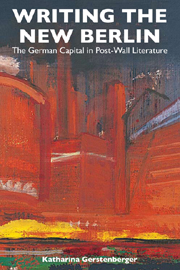Book contents
- Frontmatter
- Contents
- Acknowledgments
- Introduction: Newness and Its Discontents: Berlin Literature in the 1990s and Beyond
- 1 Erotic Sites: Sexual Topographies after the Wall
- 2 Bodies and Borders: The Monsters of Berlin
- 3 Multicultural Germans and Jews of Many Cultures: Imagining “Jewish Berlin”
- 4 Goodbye to East Berlin
- 5 Looking for Perspectives: The Construction at Potsdamer Platz
- Conclusion
- Bibliography
- Index
3 - Multicultural Germans and Jews of Many Cultures: Imagining “Jewish Berlin”
Published online by Cambridge University Press: 05 February 2013
- Frontmatter
- Contents
- Acknowledgments
- Introduction: Newness and Its Discontents: Berlin Literature in the 1990s and Beyond
- 1 Erotic Sites: Sexual Topographies after the Wall
- 2 Bodies and Borders: The Monsters of Berlin
- 3 Multicultural Germans and Jews of Many Cultures: Imagining “Jewish Berlin”
- 4 Goodbye to East Berlin
- 5 Looking for Perspectives: The Construction at Potsdamer Platz
- Conclusion
- Bibliography
- Index
Summary
… the German Jew served — before and after the Holocaust — as a screen onto which others, Europeans in particular, have projected their wishes and anxieties.
— John Borneman and Jeffrey Peck, SojournersThe intense and often contentious attention lavished on Jewish Berlin brings decades of German engagement with the Nazi past and the Holocaust into the post-unification period. In the 1990s Jewish Berlin began to play an important role in Germany's claim to normalcy, which required both acknowledging guilt and bringing the process of atonement into the amalgam of post-wall identity.
Two main themes drive the discourse about Jewish Berlin. The first is the quest to explore, describe, and illuminate the realities of Jewish life and experience in Germany, past and present. The second is to sort out the place of Jews in a new Germany. While some, including the philosopher Diana Pinto or the cultural critic Eike Geisel, regard Jewish Berlin as nostalgia for a culture that never really existed, others vigorously engage in documenting and memorializing the lives and fate of Jews in Berlin after 1933. This conversation about Jewish Berlin is by no means limited to Jews: Jews and non-Jews, within and beyond German borders, participate in the dispute regarding projections about German Jews and Jewish realties. It is reflected in literary texts focusing mainly on neighborhoods in which Jews used to live until the 1930s. Remnants of this history still exist, preserved or restored sites influence how this history is perceived, and certain aspects of Jewish culture have experienced a revival since the 1990s.
- Type
- Chapter
- Information
- Writing the New BerlinThe German Capital in Post-Wall Literature, pp. 77 - 108Publisher: Boydell & BrewerPrint publication year: 2008

